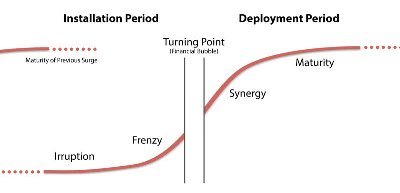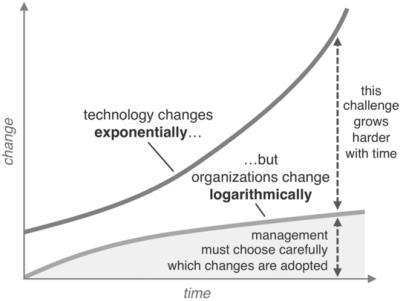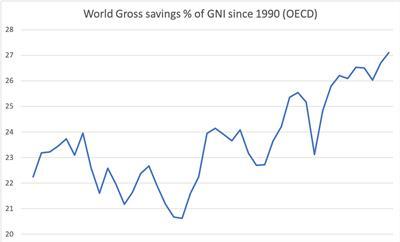Jeremie Averous's Blog, page 23
September 26, 2020
How a Diverse Team Is Needed for Innovation
In his post ‘Are You A Maverick Or A Heretic?‘, Howard Getson makes the point that throughout history, many innovators have been rejected (or even burnt at the stake) for their ideas that would prove right later. Thus if innovation is to take hold, the visionary innovator needs to be supported and surrounded by people of various personality types that ground him or her in real life.

“I love being around entrepreneurs because a lot of them are Quick Starts, and they share this future-focused perspective. The problem, however, is that when you say something’s possible that hasn’t been proven yet, the average person responds with “no it’s not.” I’ve seen the pattern over and over“
“if you’re naturally a visionary, feel free to embrace it, but surround yourself with people who keep you grounded in reality. We’d never have innovation if it wasn’t for you, and innovators wouldn’t ever get anything done if it wasn’t for other personality types.”
Innovation is not just having a great idea. It is also about inducing change in society and creating conditions for the internalisation of innovation as a foundation for future progress.
Innovation and disruption is not an individual game. It’s a team game, with diverse people supporting and helping spread the idea. It is a community game, because building a community is today the engine for spreading ideas.
The post How a Diverse Team Is Needed for Innovation first appeared on The Fourth Revolution Blog.

September 24, 2020
How the Carlota Perez Framework Explains Major Technological Disruptions and Related Financial Crashes
Carlota Perez is a well known economics scholar and her framework to explain major technological disruptions is well quoted. Basically she distinguishes an initial installation phase, followed by a deployment phase. But more importantly, her framework predicts a major crisis between both phases, generally in the form of a financial or stock market crash.

This approach is quite interesting historically and tends to explain some major crashes like the internet-induced crash of 2000, and previous crashes linked to the disruption of certain technologies (from railways to gasoline engines, see the summary of her book ‘Technological Revolutions and Financial Capital’ on Wikipedia). The point is “nothing important happens without crashes“.
Hence, destructive creation due to innovation also means financial crashes. They can’t be avoided because this is the crisis period where the previous technology becomes obsolete and leaves the way open to the new, disruptive technology. There is necessarily a switch in capital allocation and this happens through a financial crisis.
The argument is interesting, and one can wonder whether we may not take it the other way around: is each major financial crisis the reflection of an underlying disruptive technology taking hold, creating a deep transformation of the world?
The post How the Carlota Perez Framework Explains Major Technological Disruptions and Related Financial Crashes first appeared on The Fourth Revolution Blog.

September 22, 2020
How Organisations Need Both Designed and Emergent Structures
A recommended book about system thinking is the textbook ‘the systems view of life’ by Fritjof Capra and Pier Luigi Luisi. It is a quite enlightening read. One of the topics addressed in the books is emergence. In complex systems, emergence occurs when an entity is observed to have properties its parts do not have on their own. And the point made by the authors is that organisations need to have both at the same time and established formal organisation, and an informal emerging one.

“Human organisations always contain both designed and emergent structures. The designed structures, as described in its official documents. Ther emergent structures are created by the organisation’s informal networks and communities of practice. The two types of structures are very different, and organisations need both kinds.”
The future of the organisation is generated by the tension between both types of organisation. “In every organisation there is a tension between its designed structures, which embody relationships of power, and its emergent structures, which represent the organisation’s aliveness and creativity.”
While I have always observed the importance of the informal organisation for the formal to work properly, the new point here is to see it also as part of the emergence. And this also means that somehow, the informal organisation is in some ways the draft of the future organisation.
How is your emerging informal organisation doing? Can we accelerate transformation by leveraging on this informal organisational emergence?
The post How Organisations Need Both Designed and Emergent Structures first appeared on The Fourth Revolution Blog.

September 19, 2020
How Large Companies Have a Challenge in Personalizing Service
In this post ‘The Coronavirus Shows Why, if They are to Stay Healthy, Companies Need to Rethink Practices‘, Valeria Maltoni shares her experience with companies struggling to align their communication and practices in the midst of the Covid-19 crisis. She also shares an interesting little illustration which we reproduce here.

Beyond her particular experience, this post inspires me to consider how little companies have grown to develop personalized and responsive experiences, while technology would now allow this. The author gets an automated message from an airline about her oncoming trip while all flights have been cancelled. When events happen, industrial-age systems don’t bother and continue to plough away. They are not flexible and responsive to events. They don’t deliver personalized advice and information.
Large industrial organisations that will manage to develop this level of personalized services will take a lead as that is increasingly what customers expect. They get personalized advertisements and messages from internet platforms. Why do they continue to be treated as a uniform mass by service companies?
When technology changes exponentially and organizations change logarithmically, at some stage there will be a massive disruption. It is coming.
The post How Large Companies Have a Challenge in Personalizing Service first appeared on The Fourth Revolution Blog.

September 17, 2020
How Remote Work Will Extend But Still Not Become the New Normal
The experience of remote working has dramatically spread this year with the pandemics. As soon as the worst was over however, many employers tried to revert back to the previous normal, but many employees actually enjoyed the experience. Cal Newport in this New Yorker column ‘Why Remote Work Is So Hard—and How It Can Be Fixed‘ provides interesting insights.

In this post we learn that the concept of ‘telecommuting’ was actually created in the 1970s to address congestion. But the concept struggled to spread, ““Flexible work” arrangements tend to be seen as a perk; a 2018 survey found that only around three per cent of American employees worked from home more than half of the time.”
“But there were other, entirely legitimate reasons for companies to retreat from [remote work], and they are just as relevant today as they were a decade ago [when Yahoo asked everybody to be back at the office.” The issue is about informal interaction, integration of newcomers into the community, the need for individuals to have interaction. “Face-to-face interactions help people communicate and bond, but that’s only part of their value. The knowledge work pursued in many modern offices—thinking, investigating, synthesizing, writing, planning, organizing, and so on—tends to be fuzzy and disorganized compared to the structured processes of, say, industrial manufacturing.”
Cal Newport continues by seeing the transformation into full remote work being a slow process, and offices – and office time – remaining an important part of everyone’s life in the next decades. Still, there will be more remote work. New personal discipline and habits will need to be introduced, and new collaborative tools and approaches will be perfected as well.
Aligned with Cal Newport views, I observe that during the pandemics some companies commented that remote work would become the new normal, only to relent as soon as restrictions were lifted, most companies seeing only maximum one or two remote days per week being the maximum allowable. Still it will provide knowledge workers with a new rhythm and possibly a new way of living.
The post How Remote Work Will Extend But Still Not Become the New Normal first appeared on The Fourth Revolution Blog.
[image error]September 15, 2020
How Modern Learning is On-Demand, Bite-Sized
In this post ‘The Upcoming Journalism School Overhaul‘, Frederic Filloux expands about modern education and learning in the specific context of journalism. One of the aspects he highlights is how differently people acquire skills today, thanks to inline bit-size tutorials.

Before, one had to master extensively and widely all techniques associated with its trade before being considered competent (hence, the master and companions approach). Now, “Today’s generation has a completely different approach when it comes to acquiring technical knowledge: they will call for it on a need-to basis, in response to a specific project requirement. They will go on YouTube, which is also an unfathomable resource for skill-learning, to understand how to do a specific kind of shooting or mastering a particular editing technique. This is the way things are done now.“
Modern learning is on-demand, bite sized, and leverages on shared platforms, possibly with collective knowledge sharing. Industrial-age learning models, based on classrooms and large institutions, will get upended up to a certain point. And this is a good thought to have when developing new learning offers. It is important to fit with the new expectations of on-demand, bite-sized learning experiences.
The post How Modern Learning is On-Demand, Bite-Sized first appeared on The Fourth Revolution Blog.

September 12, 2020
How the Silicon Valley Origin is Actually Related to WW2 Defense Effort
I can only encourage you to take some time and read the series of blog posts by Steve Blank (an entrepreneur and Stanford professor) about the secret history of the Silicon Valley (first post of the series: ‘If I Told You I’d Have to Kill You: The Story Behind “The Secret History of Silicon Valley”‘). There is also a Youtube presentation by the same Steve Blank.

This series of posts is incredibly instructive and starts with electronic jamming devices developed during World War 2 to jam German anti-aircraft radar during bombing raids over occupied Europe. Subsequently with the Cold War, many efforts were made in programs financed by the military to continue to develop advanced electronic warfare devices. One particular challenge was to be able to get bombers in the Soviet Union for a first nuclear strike, overcoming the extensive radar and electronic defense coverage.
Beyond the extremely interesting accounts for this period, we find that most of the initial Silicon Valley innovation ecosystem was centered around Stanford and defense efforts in the electronic warfare field. Arpanet, the origin of internet, is of course another defense programme designed to sustain communications even in case of nuclear damage. Therefore the Silicon Valley is the child of a large government, defense related program. It is the consequence of another breakthrough of WW2 and, industrial-age like, is a centrally financed effort.
Therefore, if you seek to emulate the Silicon valley today (like half of the governments would dream to), that may be a bit hard, because the roots of this unique ecosystem go back a long time, to a heavily funded, continuous effort from WW2 to the Cold War over five decades.
Hat tip to Nicolas Colin as I found the reference in his excellent book ‘Hedge: A Greater Safety Net for the Entrepreneurial Age‘ – more on this book reading notes in future posts.
The post How the Silicon Valley Origin is Actually Related to WW2 Defense Effort first appeared on The Fourth Revolution Blog.

September 10, 2020
How the World is Having a Savings Glut and This Will Accelerate
We are currently in a situation of excess savings in developed countries and therefore unprecedented availability of private funds for all sorts of new ventures including the most risky innovations and fundamental research projects (for example see our post ‘How Fundamental Scientific and Technological Programs are Now Run in a Competitive Manner by Private Companies‘). This excellent post ‘The Global Savings Glut, a Modern Policy Failure‘ gives a useful explanation of this situation which pervades our economic system and has accelerated since the 2008 crisis.

“We are operating in a world where there is a massive excess of capital vs. productive places to put it. Which is why valuations on high quality assets able to absorb this savings is so high.” And thus, when there is some start-up that looks like it could become high quality, it instantly attracts capital.
The analysis is that while China became the manufacturing center of the world, it did not let its currency appreciate, and started generate high levels of local positives as well. With goods becoming ever cheaper, savings capability increased in developed countries. “Globalization ended in 2011 and no one adjusted. Export based policy and high savings rates reinforced each other even as globalization forces weakened starting in 2011.” And of course, the constant policy of very low interest rates. With “the amount of savings in Asia and Europe far bigger than the size of their domestic asset markets“, the money pours into the US markets, killing in the process all sorts of possible US monetary policy.
It seems that with the pandemics the current trend will rather accelerate with ever cheaper money being poured to the economy. This can only increase the savings glut, make valuable assets more expensive, but also continue to foster private capital being poured into all sorts of fundamental initiatives that were previously performed by governments.
The post How the World is Having a Savings Glut and This Will Accelerate first appeared on The Fourth Revolution Blog.

September 8, 2020
How Fundamental Scientific and Technological Programs are Now Run in a Competitive Manner by Private Companies
Following up on our previous post ‘How Private Initiatives to Reach the Graal of Nuclear Fusion Show a Tipping Point in the Financing of Fundamental Science‘ that expanded on TAE technologies (a US West Coast startup close to Stanford), another similar start-up – this time on the US East Coast close to the MIT – Commonwealth Fusion Systems, has also recently raised dozen million dollars for the same goal, using a different technology (see here the Wikipedia entry on Commonwealth Fusion Systems).
 Commonwealth Fusion Systems Tokamak system
Commonwealth Fusion Systems Tokamak systemIn the same year where the US is gone back to space thanks to private companies such as Space X, with an alliance of high technology and design, this really raises the question of the future role of governments in running fundamental scientific experiments and high technology programs by themselves. The aspect which I want to expand here is actual execution of advanced science and technology leveraging on competition.
Both the new space programme and the new fusion efforts appear to share the same principle of competition (Space X, Boeing and other ventures competing for the NASA contract, several companies competing for fusion) . Where in the past large science experiments were run in monopoly fashion (NASA space program, or ITER in fusion), the new world of abundance of private funding (and increased scarcity of public funding) allows to run these high-risk programs with several teams in competition. This is probably an excellent thing to reach the goal quicker and with better quality: a spirit of competition, the emergence of a variety of ideas and solutions, everything that innovative programs should seek (and have sought, as in the famous parallel development of uranium-based and plutonium-based solutions during the Manhattan nuclear project).
I believe this is a fundamental shift in how science is getting done, and not sufficiently noticed. Monolithic state research organisations need to get into this new world of competitive fundamental research, fostering initiatives instead of trying to capture them and run them by themselves.
The post How Fundamental Scientific and Technological Programs are Now Run in a Competitive Manner by Private Companies first appeared on The Fourth Revolution Blog.

September 5, 2020
How to Use Modern Mantras in the Modern World
I like this article ‘To get better at life, try this modern mantra‘. Mantras are short sentences that can be repeated and are used extensively by meditation practitioners, among others. And “modern mantras [are] simple sayings that you can call upon at any time to foster equanimity, compassion, insight, or whatever the moment calls for.”

The suggested mantra suitable to the modern world is “Right now, it’s like this” (the article was written in 2019 but this works quite well even during the Covid-19 crisis!). This mantra helps accept reality as it is.
And repeating the mantra seems to have quite some soothing effect on one’s brains and moods. The practice is this – repeat often in a reflective mode, and particularly when you become upset by something.
Repeat after me: “Right now, it’s like this“! And breathe…
The post How to Use Modern Mantras in the Modern World first appeared on The Fourth Revolution Blog.




